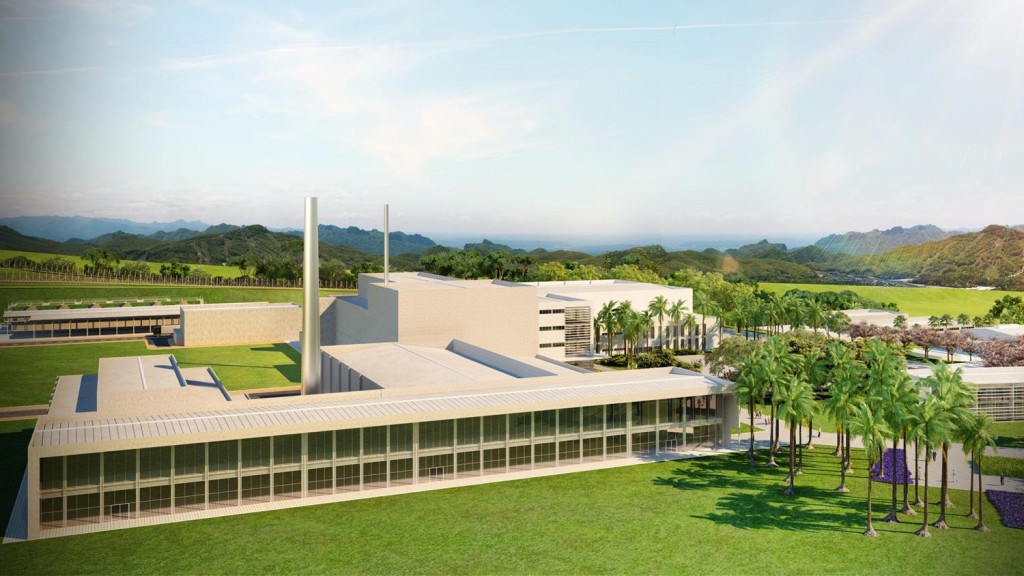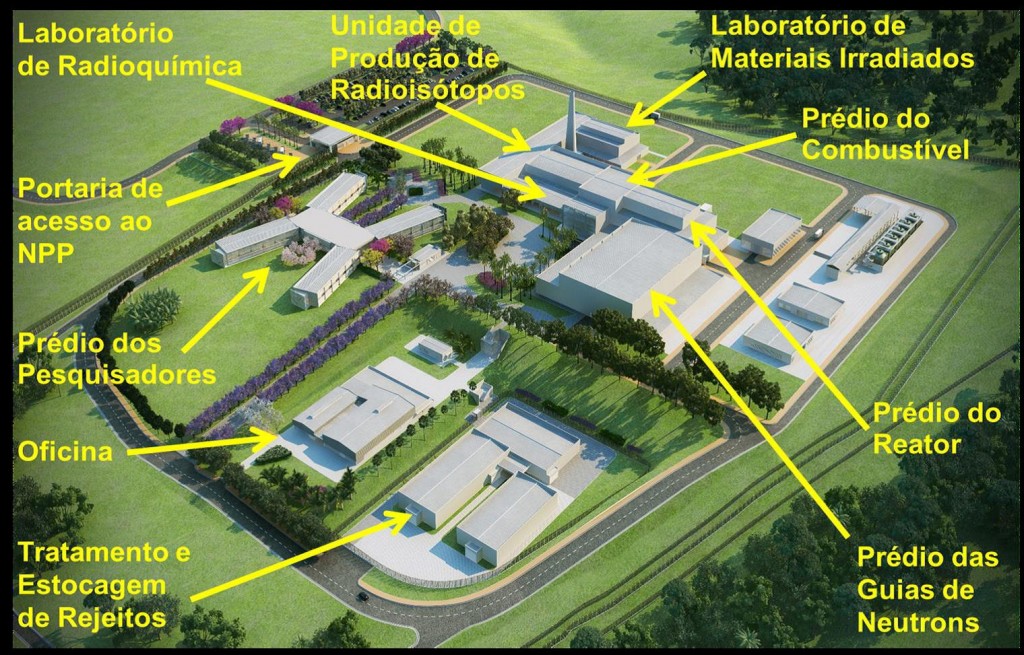
At the end of September 2015, in the context of the XIV SBPMat Meeting, around 40 researchers of the Materials field participated in a symposium about the Brazilian Multipurpose Reactor (RMB), a project that has been developed by the Brazilian National Nuclear Energy Commission (CNEN) and that, when inaugurated in Iperó (SP), will add an important research tool to the current facilities that Brazil has.
As a matter of fact, the RMB will provide beams of neutrons that, when interacting with samples and with the mediation of several experimental techniques, will be able to provide unique information about the structure of the materials. For such, the RMB project envisions the construction of a series of laboratories with diffractometer equipment (of high resolution, of high intensity, Laue, of residual tension); small angle scattering; analysis of prompt gamma; triple-axis spectrometry and neutrongraphy, among other techniques. This research infrastructure must comprise a laboratory open to the scientific community and working day and night, more than 300 days a year: the Brazilian National Laboratory of Neutrons.
As indicated by its name, RMB will meet several goals. Besides providing beams of neutrons for scientific research, it will be used in irradiation tests of materials and fuels used in nuclear power plants for electricity generation and submarines propelled by nuclear reactors, for instance. The reactor will also have the important mission of producing radioisotopes and radioactive sources for health, industry, agriculture and environment, replacing imports and even generating exports.
Interview with the technical coordinator
To further explain the RMB project and, in particular, its applications in materials science and technology, we interviewed José Augusto Perrotta, technical coordinator of the RMB enterprise. Master in Nuclear Engineering by the Military Institute of Engineering (IME), and PhD in Nuclear Technology by the São Paulo University (USP), Perrotta works as technologist at CNEN since 1983.
SBPMat Newsletter: – Briefly comment about all the possibilities that the future RMB will offer to the materials science and technology community. In what way the beams of neutrons can be used for research and development in this area?

José Perrotta: – RMB is an enterprise that has as its core part a nuclear multipurpose research reactor and several laboratories to perform research, services and products.
The reactor was conceived with a high flow of neutrons to:
i. Produce radioisotopes in the quality and amount needed to Brazilian applications;
ii. Have the ability to irradiate and test nuclear fuels used in the several applications and irradiation conditions within the Brazilian nuclear program;
iii. Have the ability to irradiate materials with neutrons and check its performance under irradiation;
iv. Have the possibility to irradiate samples to perform a chemical analysis via activation of neutrons;
v. Extract beams of neutrons for research on materials structure in several application areas.
Regarding item (ii), the reactor is prepared to receive fuel samples and irradiation circuits that simulate the conditions of PWR reactors, that is, test fuels of the power reactors used or developed in the country.
Regarding item (iii), inside the reactor core there are two positions with high flow of neutrons for irradiations of materials. In these positions, samples can be placed in capsules with a controlled environment (temperature and medium of insertion of the sample). In these positions, samples of structural materials and samples of components of power reactors used in the country can be tested.
The reactor and the infrastructure of the reactor (pools, hot cells and transport shields) are designed to meet the two previous items (ii and iii).
A Post-Irradiation Analysis Laboratory is designed with hot cells and the entire infrastructure for mechanical, physical and microscopy analysis of the irradiated samples, both for the samples of irradiated fuels and for the structural materials.
Regarding item (iv), a laboratory of analysis by activation and radiochemistry is projected. The laboratory is connected to the reactor via pneumatic pipes that allow sending samples for irradiation in the reactor and bring them back to the laboratory for analysis. Several irradiation positions were defined in the reactor, varying the range of flow of neutrons in which the irradiations can be performed. The laboratory has hot cells to receive and handle the irradiated samples before their destination to the analysis equipment (radiochemistry or gamma spectrometry). The laboratory will be managed as a national laboratory, which will allow its use by the Brazilian scientific community.
Regarding item (v), the reactor is designed with a heavy water reflector tank that, mechanically, allows the extraction of beams of neutrons. These neutrons are thermal, and in order to obtain cold neutrons a small tank with deuterium at 19ºK (cold source) is designed. Thermal neutrons will be extracted in two positions and cold neutrons in two other. Each extraction tube may contain up to three neutrons guides. These guides will conduct the beam of neutrons for positions in a lobby of experiments at the building of the reactor, and in a building called neutron guides building. Scientific and technological equipment can be attached to the neutron guides for the analysis of the samples with the beam of neutrons. There is an additional thermal neutron extraction tube to make images with beam of neutrons (neutrongraphy). The experiments lobby in the reactor building and the guides building will form what we call “National Laboratory of Neutrons” (LNN).
SBPMat Newsletter: – Will there be experimental stations for Materials Science and Technology, analogous to the Brazilian Synchrotron Light Laboratory (LNLS)? Which ones? Will they be open to the entire scientific community? Will they operate constantly while the reactor is working?
José Perrotta: – The neutrons lines, as mentioned, are five: three with thermal neutrons and two with cold neutrons. Four of the lines can have up to three guides. In these guides, the experimental instruments (or stations) will be placed.
The following stations might be available since the beginning of the operation of the National Laboratory of Neutrons
i. Neutrons Guides Building.
- For thermal neutrons: High Resolution Diffractometer; High Intensity Diffractometer; Laue Diffractometer; Residual Tension Diffractometer.
- For cold neutrons: Small Angle Scattering; Prompt Gamma Analysis
ii. Experiments Lobby in the Reactor Building.
- Thermal Neutrons: Triple Axis Spectrometer; Neutrongraphy

The RMB will bring to the country’s research community an important laboratory for utilization of neutrons beams. This laboratory, per its technical characteristics, is complementary to the Brazilian Synchrotron Light Laboratory (LNLS), which also has a large scale project, the Sirius. It is a proposal of the RMB enterprise that the National Laboratory of Neutrons is, like the LNLS, a national laboratory. This will facilitate the access of the Brazilian scientific society to the facility.
The functioning of the neutrons lines is related to the operation of the reactor. The reactor will operate 24 hours a day, in cycles of 25-28 days, in a way to achieve availability higher than 80% of the annual time (more than 300 days in full operation). The LNN can operate during all this time.
An important point is that the LNN will be operationally independent regarding the operation of the reactor, that is, the operation of the reactor offers the beam of neutrons and does not interfere in the operation of the LNN.
SBPMat Newsletter: – From the point of view of materials science and technology, which would be the advantages of the future RMB regarding the other reactors currently existing in Brazil?
José Perrotta: – Brazil has four research nuclear reactors in operation. The oldest one, and also the one with higher power (5 MW), is the IEA-R1 reactor from the Institute for Nuclear and Energy Research (IPEN) in São Paulo, which was unveiled in 1957. Other two low power research reactors, the IPR-R1 reactor of the Center for Nuclear Technology Development (CDTN) in Belo Horizonte (100 kW) and the Argonauta reactor of the Institute for Nuclear Engineering (IEN) in Rio de Janeiro (500 W) were built in the 1960s. These three reactors, of North-American designs, were built inside the university campuses of USP, UFMG and UFRJ, respectively, and originated the main nuclear research institutes of the Brazilian National Nuclear Energy Commission (CNEN), which developed themselves in proportion of the size of the reactors and their applications. These reactors and the CNEN institutes growing around them were essential in the development and use of nuclear technology that we have in the country today, and in the formation of the associated human resources. The fourth research nuclear reactor, the IPEN/MB-01 at IPEN, is an installation of the critical unit type (100 W) and was built in the 1980s, already with national technology, aiming towards the autonomous development of technology for power nuclear reactors.
The RMB reactor´s power is 30 MW and has modern design and conception. The reactors existing today in the country do not have flow of neutrons to ensure commercial operation or adequate characteristics for a high level research. In addition to being a more modern installation, the flow of neutrons of the RMB is one order of magnitude higher than the IEA-R1, and has functions that are not met by this reactor today. The other three reactors have really low flow of neutrons.
SBPMat Newsletter: – Could you estimate when the RMB and its research laboratories would be launched?
The RMB enterprise can be carried out in a period of 6 to 7 years. In the current stage of development, this would occur in 2022, if the full resources for the project are made available. It is important to highlight that, besides the need for intensive financial resources for its execution, the enterprise requires environmental and nuclear licenses for its construction and operation, since it has nuclear and radioactive facilities. This implies additional times for its implementation.
Funders and partners in the development of the RMB
The execution of the RMB project occurs under the responsibility of the Brazilian National Nuclear Energy Commission (CNEN).
The enterprise is coordinated by the Research and Development Directory of CNEN and developed by its research institutes: Nuclear Energy Research Institute (IPEN), Nuclear Engineering Institute (IEN), Nuclear Technology Development Center (CDTN), Northeast Regional Center of Nuclear Sciences (CRCN-NE) and Radiological Protection and Dosimetry Institute (IRD).
Throughout the stages of development of the RMB, CNEN counts and will count on partnerships, as well as contracts of national and foreign companies. Some of the partners participating so far: Brazilian Navy and the São Paulo State government, in the concession of the land where the RMB will be placed; the Brazilian Navy Technology Center in São Paulo (CTMSP); the cooperation of CNEN with the National Atomic Energy Commission (CNEA) from Argentina, which develops in Argentina the research nuclear reactor RA-10, similar to RMB. Contracted companies: Argentine company INVAP, which designed the Australian OPAL research reactor, and Brazilian company Intertechne have developed the basic engineering design of the enterprise.
With an estimated cost of US$500 million, the RMB is sponsored by the Brazilian Federal Government through the Brazilian Ministry of Science, Technology and Innovation (MCTI).

Charles Adriano Duvoisin
Bom dia a todos! No caso de eu possuir uma patente, a qual seja uma hipótese de criar isótopos atraves de um sistema e metodo inédito mundialmente … Todavia esta pesquisa necessitará de alguns ajustes… Pergunto: Onde poderei realizar este experinto de forma rápida e segura? Forte abraco a todos….
Maiza Chiang
Quero umas respostas resumidas de;
sobre o valor do projeto de construção do RMB?
Sua localização geográfica ?
Qual o prazo de conclusão ?
Como esta o andamento ?
Qual a sua dimensão ?